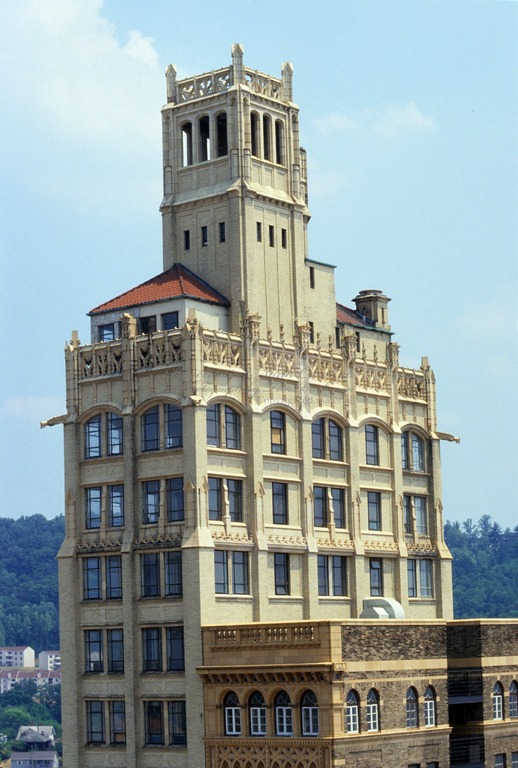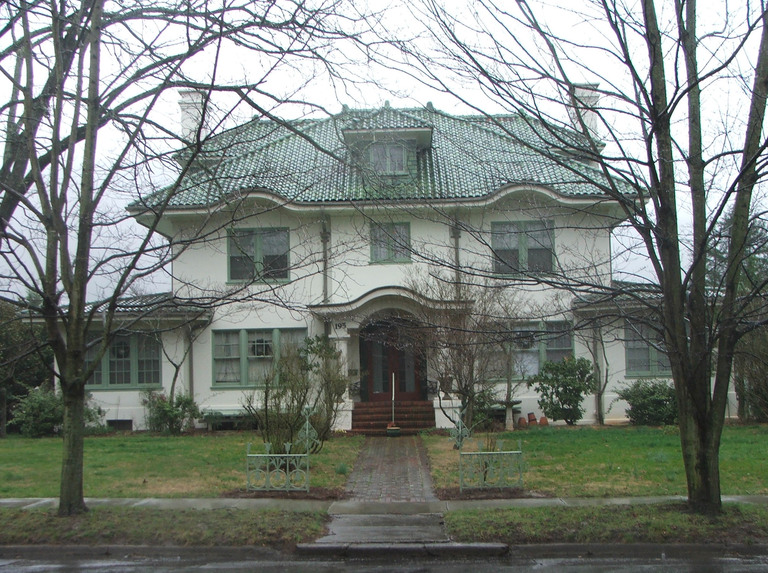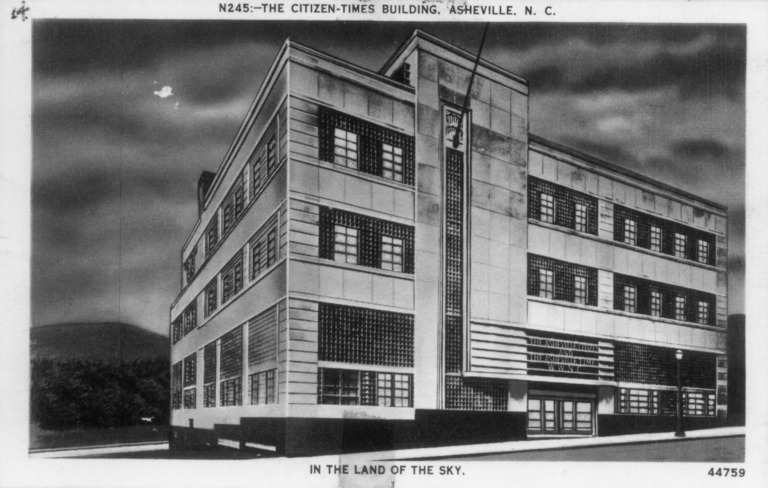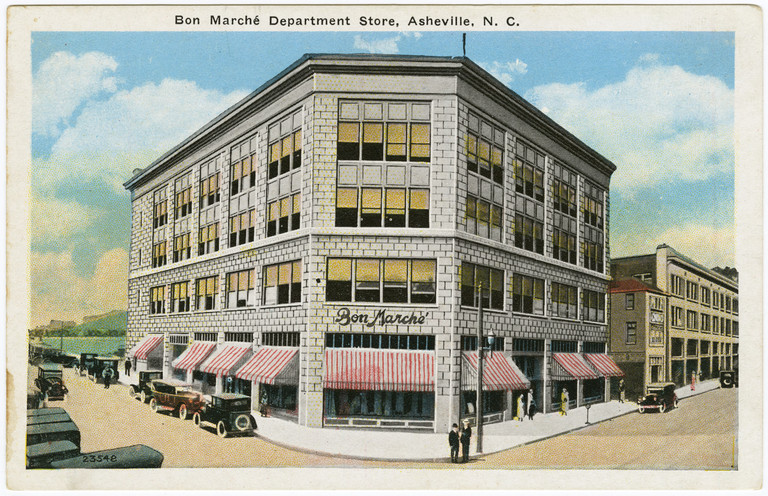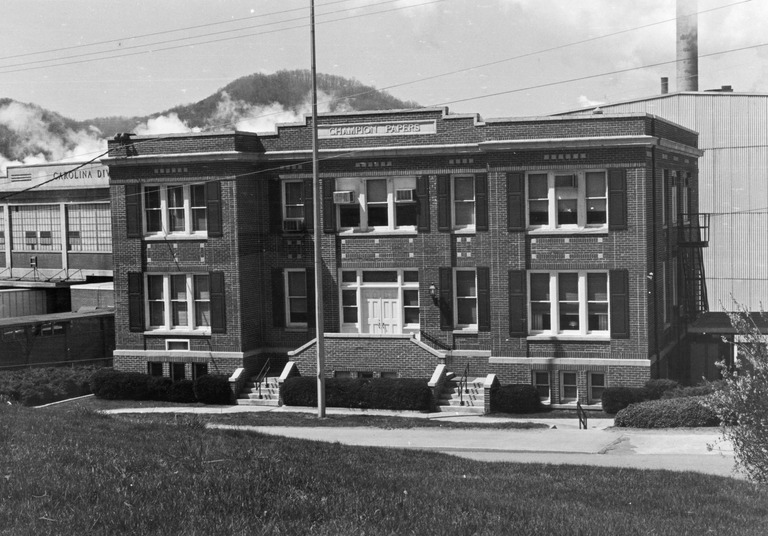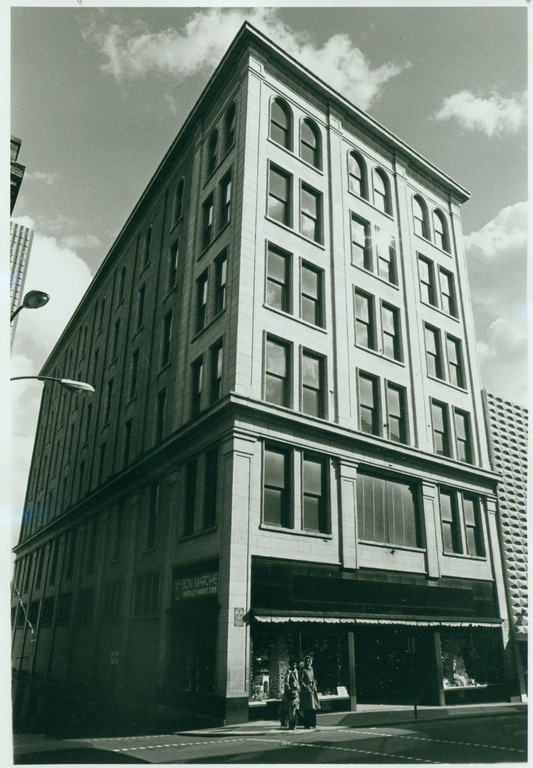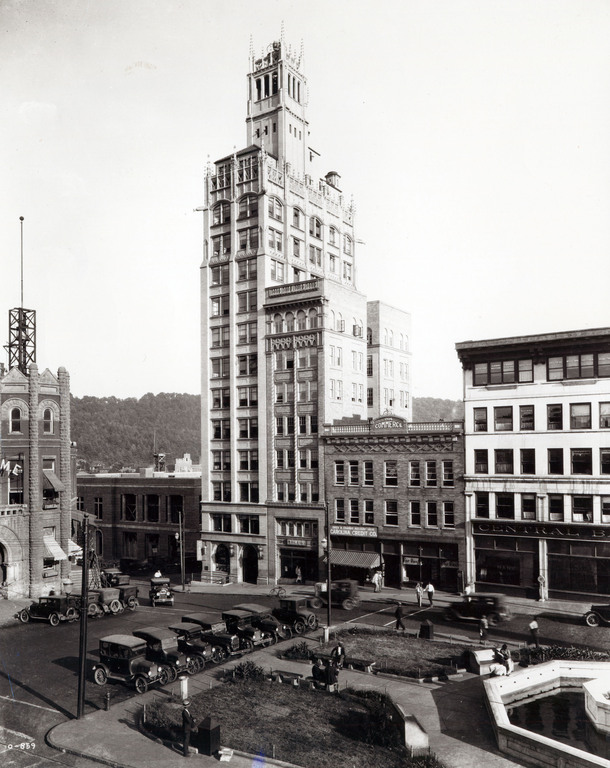Merchant, Luther L. (1876-1966)
Variant Name(s):
Luther Launcelot Merchant
Birthplace:
Brooks, Indiana, USA
Residences:
- Asheville, North Carolina
- Henderson County, North Carolina
Trades:
- Contractor
NC Work Locations:
Building Types:
Styles & Forms:
Colonial Revival; Gothic Revival; International style; Neoclassical Revival
Luther Launcelot Merchant (1876-1966), a contractor who was called a “construction pioneer” in Asheville, took a central role in building the city’s notable early 20th century architecture. A native of Brooks, Indiana, he was the son of John and Eliza Jane Hess Merchant. The family moved to Henderson County, North Carolina in about 1885. Luther attended local schools, enlisted for service in the Spanish-American War, and then moved to Asheville about 1904. Listed in the local city directory of 1904-1905 as a carpenter, and by 1909 as a contractor, he initially worked for Asheville builders including J. C. MacPherson, for whom he served as foreman for seven years.
By about 1911, according to an article in the Asheville Citizen (July 6, 1924), Merchant “decided that he had sufficient experience to go into the game for himself,” and he joined with “several good men” including his brother, Oscar, to establish a contracting business. The Merchant Construction Company grew rapidly and eventually took on projects in four states. In Asheville, the firm constructed some of the booming city’s principal buildings. Designed by various architects, these exemplified a variety of styles, forms, and construction techniques, some of them new to the city. The competence, skill, and size of Merchant’s firm were vital to the successful completion of buildings that often employed challenging construction methods and large scale work.
Probably the most famous of Merchant’s contruction projects is the Jackson Building (1923-1924), designed by Ronald Greene as a slender tower in Gothic Revival style; at thirteen stories it was the tallest building in western North Carolina and the region’s first skyscraper. The local newspaper celebrated its construction: “New Skyscraper is Totally Fireproof Declares Merchant” ran the headline in the Asheville Time on Sunday July 6, 1924. The Loughran Building (1923) was one of architect Richard Sharp Smith’s last designs, and among the city’s first structures with all steel framing. At the other end of the architectural spectrum, Merchant constructed numerous residences, often with highly refined detailing, such as the elegant rendition of Gunston Hall (1923-1924) designed by Washington, D.C. architect Waddy B. Wood for a descendant of the family who built the original colonial period Gunston Hall in Virginia. The spectacularly eclectic Public Service Building (1929) was completed on the eve of the Great Depression from designs by Beacham and LeGrand. In 1930, Merchant and his wife and children were residing in Henderson County, but they later returned to Asheville.
As construction in the city began to recover from the Great Depression, the Merchant firm gained the contract for the sleekly modernist Asheville Citizen-Times Building (1938-1939) designed by Anthony Lord—one of the first big projects in town in years, and an early example of the International Style, displaying exactingly finished concrete construction. The firm also erected many other buildings including several local schools and churches. A key postwar project was Beth Ha-Tephila Temple (1948-1949), designed by the prolific local architectural firm of Six Associates. Merchant retired as president of his construction company in 1950 and after 1952 spent much of the year in Lakeland, Florida, while returning to Asheville in the summers. He married first Almetta Harris (d. 1938) with whom he had two sons, and then Mrs. Pinkney Smith (d. 1958).
- Asheville Citizen, July 6, 1924.
- Asheville Citizen-Times, Aug. 24, 1966.
- Catherine W. Bishir, Michael T. Southern, and Jennifer F. Martin, A Guide to the Historic Architecture of Western North Carolina (1999).
- David R. Black, Historic Architectural Resources of Downtown Asheville, North Carolina (1979).
- Charlotte Vestal Brown Papers, Special Collections Research Center, North Carolina State University Libraries, Raleigh, North Carolina.
- Douglas Swaim, ed., Cabins and Castles: The History and Architecture of Buncombe County, North Carolina (1981).
Andrew Gennett House
Contributors:William J. East, architect; Luther L. Merchant, contractorDates:Ca. 1926-1927
Location:Asheville, Buncombe CountyStreet Address:195 Kimberly Ave., Grove Park, Asheville, NC
Status:Standing
Type:Residential
Note:William J. East’s (undated) drawings of the boldly composed Andrew Gennett House survive at the Pack Library, Asheville. The address first appears in the Asheville city directory of 1927.
Asheville Citizen-Times Building
Contributors:Anthony Lord, architect; Luther L. Merchant, contractorDates:1938-1939
Location:Asheville, Buncombe CountyStreet Address:14 O. Henry Ave., Asheville, NC
Status:Standing
Type:Commercial
Images Published In:Catherine W. Bishir, Michael T. Southern, and Jennifer F. Martin, A Guide to the Historic Architecture of Western North Carolina (1999).
David R. Black, Historic Architectural Resources of Downtown Asheville, North Carolina (1979).
Beth Ha-Tephila Temple
Contributors:Dates:1948-1949
Location:Asheville, Buncombe CountyStreet Address:43 N. Liberty St., Asheville, NC
Status:Standing
Type:Religious
Bon Marche Department Store
Contributors:Ronald Greene, architect; Luther L. Merchant, contractorDates:1937
Location:Asheville, Buncombe CountyStreet Address:33 Haywood St., Asheville, NC
Status:Altered
Type:Commercial
Note:Pack Memorial Library in Asheville has Greene’s architectural drawings for Bon Marche.
Champion Fibre Company Main Office
Contributors:Dates:1918
Location:Canton, Haywood CountyStreet Address:14 Main St., Canton, NC
Status:Standing
Type:Industrial
Images Published In:Catherine W. Bishir, Michael T. Southern, and Jennifer F. Martin, A Guide to the Historic Architecture of Western North Carolina (1999).
Camille Wells, Canton: The Architecture of Our Home Town (1985).Note:A principal landmark in Canton, the handsome office building was headquarters for the firm that built the town’s principal industry the Champion Paper Company. The Champion Log noted that the brick came from Fletcher, N. C., and the granite from Mount Airy. The Asheville Citizen-Times of September 29, 1912, also credited William H. Lord with designing a bank in Canton and another in nearby Waynesville (the latter was also cited in the same paper in September 1903). These have not been identified.
Dr. W. P. Herbert House
Contributors:Luther L. Merchant, contractorDates:1920s
Location:Asheville, Buncombe CountyStreet Address:Albemarle Park, Asheville, NC
Status:Standing
Type:Residential
Fernihurst
Contributors:Henry Irven Gaines, architect (1930s); Luther L. Merchant, contractor (1930s)Dates:ca. 1875; 1930s
Location:Asheville, Buncombe CountyStreet Address:Victoria Rd., Asheville, NC
Status:Standing
Type:Residential
Note:As related by Gaines in King’s Maelum, in the depths of the Great Depression, Mr. and Mrs. John F. Curran commissioned him to expand and remodel a Victorian residence they had recently acquired—a welcome project when he had no other work. He transformed it with a portico and other Colonial Revival elements. Gaines recalled that he “moved a drafting board out to the Curran house, and while Mr. Merchant [the contractor] proceeded with his work I was busy with the plans. We . . . worked out a sequence of work, listing the plans and details in the order in which he would need them. In this way I managed to keep ahead of the construction workers.”
Frank Salley House
Contributors:William Waldo Dodge, Jr., architect; Luther L. Merchant, contractorDates:1938
Location:Buncombe CountyStreet Address:354 Kimberly Ave., Buncombe, NC
Status:Standing
Type:Residential
Note:Pack Library has the architectural drawings for this house (AD0127) at 354 Kimberly Avenue, dated 1/8/1935. Also, Carolina Architecture and Allied Arts, 1939-40 edition features the Salley house with photographs.
Gennett House
Contributors:Luther L. Merchant, contractorDates:Ca. 1924
Location:Asheville, Buncombe CountyStreet Address:#1 Evelyn Place, Grove Park, Asheville, NC
Status:Standing
Type:Residential
Gunston Hall
Contributors:Luther L. Merchant, contractor; Waddy B. Wood, architectVariant Name(s):Dr. William B. Mason House
Dates:1922-1923
Location:Asheville, Buncombe CountyStreet Address:324 Vanderbilt Rd., Asheville, NC
Status:Standing
Type:Residential
Images Published In:Douglas Swaim, ed., Cabins and Castles: The History and Architecture of Buncombe County, North Carolina (1981).
Note:The William B. Mason House, built as a summer home, was designed as a rendition of Mason’s ancestor’s house in Virginia, Gunston Hall.
Honess Building
Contributors:William H. Lord, architect; Luther L. Merchant, contractorDates:Ca. 1925
Location:Asheville, Buncombe CountyStreet Address:70 Patton Ave., Asheville, NC
Status:No longer standing
Type:Commercial
J. M. Westall Building
Contributors:Luther L. Merchant, contractorDates:1923
Location:Asheville, Buncombe CountyStreet Address:NE corner Walnut St. and Lexington St., Asheville, NC
Status:Standing
Type:Commercial
Images Published In:David R. Black, Historic Architectural Resources of Downtown Asheville, North Carolina (1979).
Jackson Building
Contributors:Dates:1923-1924
Location:Asheville, Buncombe CountyStreet Address:22 South Pack Square, Asheville, NC
Status:Standing
Type:Commercial
Images Published In:Catherine W. Bishir, North Carolina Architecture (1990).
Catherine W. Bishir, Michael T. Southern, and Jennifer F. Martin, A Guide to the Historic Architecture of Western North Carolina (1999).
David R. Black, Historic Architectural Resources of Downtown Asheville, North Carolina (1979).
Douglas Swaim, ed., Cabins and Castles: The History and Architecture of Buncombe County, North Carolina (1981).Note:The slender 13-story building on a tiny lot was the first skyscraper in western North Carolina. Designed by architect Greene for young real estate developer L. B. Jackson, the steel-framed brick building features elaborate glazed terra cotta ornament in a Gothic Revival style that emphasizes its height. It stands on the lot where Thomas Wolfe’s father had his monument shop. Originally, the building had more spires and a searchlight on top that cast a beam for 30 miles.
Loughran Building
Contributors:Albert Heath Carrier, architect; Luther L. Merchant, contractor; Smith and Carrier, architects; Richard Sharp Smith, architectDates:1923
Location:Asheville, Buncombe CountyStreet Address:Haywood St. and Walnut St., Asheville, NC
Status:Standing
Type:Commercial
Northup-McDuffie Hardware
Contributors:Luther L. Merchant, contractor; Willard C. Northup, architectDates:1921
Location:Asheville, Buncombe CountyStreet Address:72-74 Patton Ave., Asheville, NC
Status:Standing
Type:Commercial
Images Published In:David R. Black, Historic Architectural Resources of Downtown Asheville, North Carolina (1979).
Note:The architectural drawings collection at the Pack Library in Asheville has the architect’s drawings of the hardware store, dated August, 1921, by architect, Willard C. Northup of Winston-Salem, who was the son of William B. Northup who owned the hardware company (see W.B. Northup obituary, Asheville Citizen, October 4, 1936).
Public Service Building
Contributors:Beacham and LeGrand, architects; Samuel I. Bean, stone and tile contractor; Luther L. Merchant, contractorDates:1929
Location:Asheville, Buncombe CountyStreet Address:89-93 Patton Ave., Asheville, NC
Status:Standing
Type:Commercial
Images Published In:Catherine W. Bishir, Michael T. Southern, and Jennifer F. Martin, A Guide to the Historic Architecture of Western North Carolina (1999).
David R. Black, Historic Architectural Resources of Downtown Asheville, North Carolina (1979).Note:The 8-story, brick skyscraper features lavish, polychrome terra cotta detailing, including various classical motifs, on every façade. It was built by the Coxe estate with Carolina Power and Light as the first tenant.
Westall Building
Contributors:Ronald Greene, architect; Luther L. Merchant, contractorVariant Name(s):Jackson Building Annex
Dates:1924-1925
Location:Asheville, Buncombe CountyStreet Address:20 S. Pack Square, Asheville, NC
Status:Standing
Type:Commercial
Images Published In:David R. Black, Historic Architectural Resources of Downtown Asheville, North Carolina (1979).
Note:Built as partner to the Jackson Building in Spanish Romanesque style over a steel frame, the Westall Building was covered with mottled orange brick trimmed with orange terra cotta picked out in green and blue. The photograph shows the Westall Building immediately to the right of the Jackson Building.

